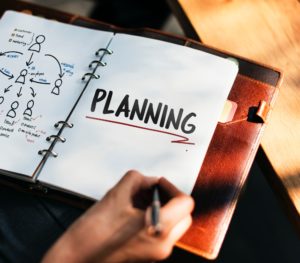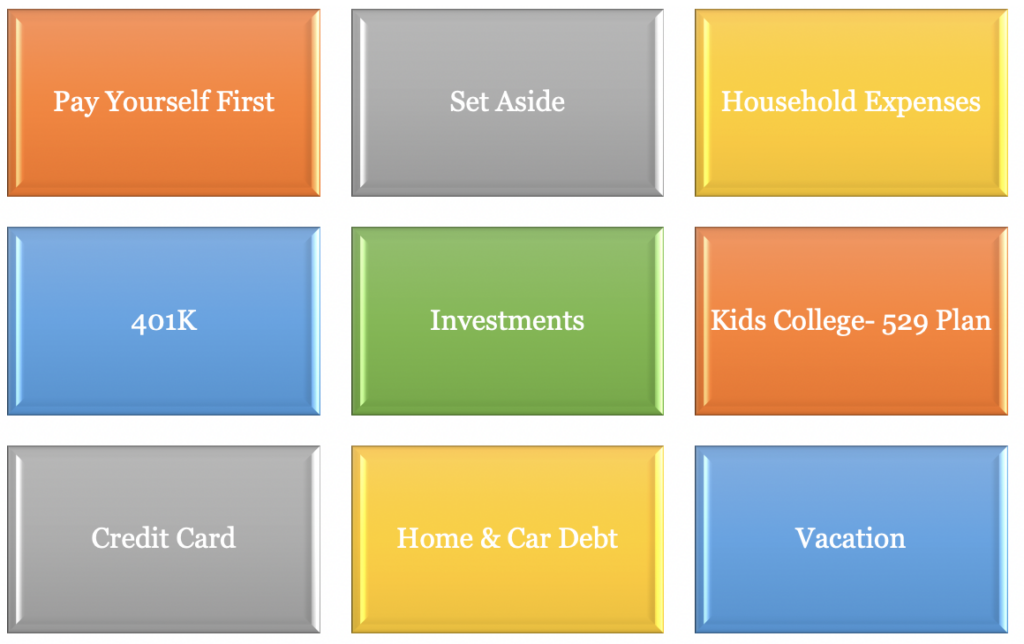
Working with young executives, and small business owners, on business development normally crosses over into various forms of life planning. Knowing the formula for having enough set aside cash on hand is important part of financial planning. A couple going through life together needs to be closely aligned when navigating their financial future by having clear life and money goals. The more aligned they are, the better and happier life will be.
Depending on where the couple is at on the economic scale, they learn to manage their money through various means. If they don’t already have a million or two in the bank, then you might want to keep reading. Typically, couples will add up all the bills when they get a paycheck. Then, they pay all the bills and say, what’s left in the bucket?
 The goal is to be financially successful. This all starts with how you spend and save money. Decide to take a percentage, 10% or greater, (20% preferably) and begin to “pay yourself first” out of every dollar you get. Then pay your bills and live off the rest. You can Google the topic and get 2,420,000,000 results. I agree with many of these resources, but some have taken the concept out of its original form only in an attempt to sell you something. Don’t fall for that.
The goal is to be financially successful. This all starts with how you spend and save money. Decide to take a percentage, 10% or greater, (20% preferably) and begin to “pay yourself first” out of every dollar you get. Then pay your bills and live off the rest. You can Google the topic and get 2,420,000,000 results. I agree with many of these resources, but some have taken the concept out of its original form only in an attempt to sell you something. Don’t fall for that.
If your living expenses are more than you make with this formula, you have to adjust your living standard to live within your means. This formula scales up as you make more money, then it starts to change when you reach a higher level based on another series of ratios.
Part of this money is to fund the buckets (not debt buckets) you need to fill. Once they are full, move on to other buckets. Please know I have not listed all the buckets.
Set Aside Cash Bucket
You first need to have “set aside cash” as part of your life plans. This money serves to cover you if you lose a job or one of you gets sick, or there is a virus that puts you on leave for six months. This is actual cash on hand; it’s not invested. It is money you can lay your hands on. It is not your 401K contributions because that money should be off-limits to use in emergencies. It is a different segment of financial planning. Early and unplanned withdrawals in a 401k have severe tax consequences that you want to avoid.
How Much Set Aside Cash Do We Need?
Many financial people say if you have 60 days of cash to cover all your bills would be enough. That’s an outdated concept. Nearly everyone in the position then lives off credit cards and relatives, or some turn to illegal methods to generate cash. It’s staggering to look at the number of bankruptcies of people living beyond their means.
When you aren’t deep into debt and have a stream of income coming in, you want to total your combined wages in a month and then keep in cash the equivalent of that times six months. If you make $4,000 per month, you need $24,000 in cash, for example. And yes, I’d want to look into secure basic investment instruments to hold part of the money. The other part, keep in cold hard cash on hand, with a private, safe place to store it.
Why Do It This Way?
This gives you peace of mind. That is a powerful friend all by itself, and it’s life-changing to know what you have set aside. It also creates disciplined money management practices. It creates the ability not to have to radically adjust your lifestyle or use a credit card to pay bills when stuff happens. And stuff will happen, it is not if, it is when. This set aside cash is created from the Pay Yourself First Bucket, and before you invest money (not your 401k), and before a house is bought… see where I am going?
This baseline allows you to know you are secure. Your next phase is starting to make calculated investments. You’ll be able to do this better because you’ll have the money and the means to accelerate the whole process.
Investing Bucket Means a Measured ROI
Many homes are not appreciating and are bought to give emotional satisfaction. From a financial perspective a “return on investment” isn’t good at all. A home can be considered an investment if it’s purchased right. The build-up of equity creates a winning combination to buy additional property as you age and your lifestyle choices evolve/change while also keeping capital gains taxes to a minimum or none at all. It can be an appreciable asset to add value to your financial portfolio. Since it is a sizable amount of money, it has to be considered with an investment mindset, not solely an emotional one.
The Smell of Money From The Stock Market
The smell of money has fooled many a man over the years. Making money through investments or the stock market requires tax planning as much as it does knowing where to invest. The amount of taxation we are taxed on after the taxes we’ve already paid to earn money can make a good man crazy. That’s a whole conversation in itself as well as aligning with professional wealth advisors.
 Investing pretax income into a 401K and having employers who match your money is a good thing and should be maxed out. I do have issues with how some of the advisors make recommendations to handle “risk factors” and how the money is allocated. These financial instruments are a wonderful piece of your financial future, but it is certainly not all of what can happen when you exercise the proper disciplines and delayed gratification principles mentioned in this article.
Investing pretax income into a 401K and having employers who match your money is a good thing and should be maxed out. I do have issues with how some of the advisors make recommendations to handle “risk factors” and how the money is allocated. These financial instruments are a wonderful piece of your financial future, but it is certainly not all of what can happen when you exercise the proper disciplines and delayed gratification principles mentioned in this article.
Future Goals and Objectives
Once your debts are cleared and the Set Aside bucket is full, those Pay Yourself First monies will go to other buckets, and new ones will be added. Determine the priorities.
Do what matters the most, not what matters the least.
Make smart choices with how you save and spend money.
The starting point of any significant financial plan starts with a written life plan. By writing out your goals as a family, the financial plans to get there start to become more apparent. If you don’t have a life plan, how will you know if you get to where you want to be? Yea, I know that sounds simple. Too many people don’t take the time to mentally go through the exercise and think they have it in their heads. If it’s not written and reviewed quarterly, you don’t have a plan.
![]()

